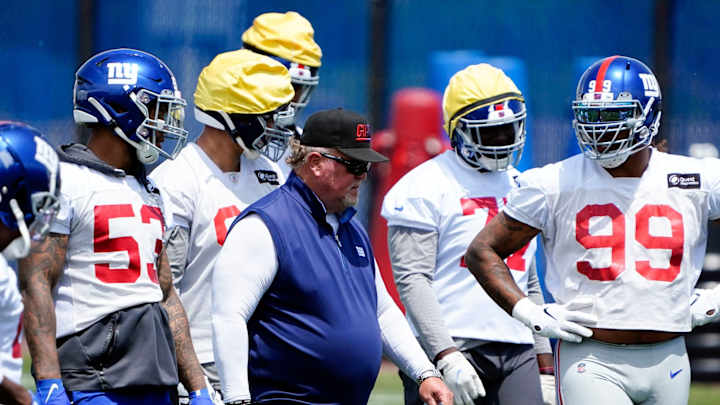The Good, Bad, and Ugly of the New York Giants Defense

In this story:
The Wink Martindale era as defensive coordinator of the New York Giants seems to have reached its end. Instead of diving into all of the conjecture surrounding his departure, this seemed like a good time to reflect on his tenure with the team and his effect on the defense.
In 2022, his defense showed promise, and we heard his name kicked around in conversations for head coaching positions. In 2023, the offensive regression and some personnel changes led to a step back in overall performance, especially in the first half of the season.
The second half seemed to mirror the unit many believed had the opportunity to be a top-five unit in the NFL. There was a lot to admire about Martindale's defense and some things that still remain a head-scratcher.
We could not possibly go through all of them individually, so, as we would with players, let’s take a look at the good, the great, and the ugly of Martindale's defensive schemes.
The Good: Pass Coverage
When most people think of a Wink Martindale defense, they think of aggression, but one thing he did as defensive coordinator for the Giants was show his ability to change up and disguise coverages.
The Coach Wink coverage packages were surprising since most considered him a strictly man-to-man coach. pic.twitter.com/2vvj5TzFnd
— Coach Gene Clemons (@geneclemons) January 13, 2024
When he took over, many believed the Giants would turn into a heavy man-to-man team, and while they did play a fair amount of men under Martindale, they also played a myriad of other coverage. The results of some of those confusing coverages were interceptions.
Other times, it forced quarterbacks to hold the ball longer and resulted in sacks, pressures, or misthrown footballs. One of the most impressive things was how many players would constantly be near the football on a pass. They did not always make the tackle, but it forced the quarterback to make tight-window throws.
The Great: Blitz Packages
Martindale has long been known for his ability to dial up blitzes that confuse offenses, get quarterbacks on the ground, or make them throw the ball away. That remained the case during his tenure in New York and while the team did not finish in the upper echelon in sack totals.
The Coach Wink blitz packages have always been 🔥🔥🔥 Whether they get home or not, they are always clever. pic.twitter.com/oq8dV3rH8M
— Coach Gene Clemons (@geneclemons) January 13, 2024
There is plenty of evidence that supports how disruptive they were when blitzing. One of the best parts of Martindale’s blitz package is showing the pressure from one side and on the snap of the ball, dropping that side and bringing the pressure up the middle or from the opposite side.
In addition, he found more success with the Giants sending defensive backs on blitzes. There have been several instances over the last couple of seasons where defensive backs have been more active behind the line of scrimmage, and seven defensive backs have recorded sacks over his two seasons with the Giants.
The ability to create pressure from the first, second, and third levels is extremely impressive.
The Ugly: Dropping Kayvon Thibodeaux in Coverage
There were a lot of people who were forced to eat crow when Kayvon Thibodeaux followed up a strong finish to his rookie campaign with an 11.5 sack season. It truly makes you wonder how much more special it could have been if he was allowed to rush the passer more.
One familiar thing to see while watching a Giants game was Thibodeaux dropping into coverage on passing downs and seeming as if he was wandering around aimlessly. One of the downsides of these exotic blitz packages is that they can result in players more adept at rushing the quarterback and being relegated to coverage duty.
Amid the lack of pass rush depth on this team and with him having a breakout season, it is still a head scratcher why Coach Wink chose to drop Kayvon Thibodeaux into coverage so much. pic.twitter.com/xZ0sSHEn5R
— Coach Gene Clemons (@geneclemons) January 13, 2024
On several occasions, Thibodeaux was not covering anything of value, and the side that he vacated seemed to always be available for the quarterback to escape from.
It is more than questionable why Martindale decided to drop Thibodeaux into coverage so often. It's borderline criminal. Even though he is athletic, as the only elite-level pass rusher consistently available with Azeez Ojulari only starting seven games this season, it would make a lot more sense to give the duties of dropping into coverage to another player, but that was not the case.
The inability to pin his ears back and focus solely on getting to the quarterback probably hurt his chances of being in the top five this season. It also cost the defense the opportunity to put more pressure on the quarterback.
There was a palpable frustration while watching the best pass rusher you have drop into coverage on passing downs and get no pressure on the quarterback. This is definitely a schematic failure that we hope the next defensive coordinator avoids.
- Follow and like us on Facebook
- Submit your questions for our mailbag
- Check out the Giants Country YouTube Channel.
- Subscribe and like the LockedOn Giants YouTube Channel

Gene "Coach" Clemons has been involved with the game of football for 30 years as a player, coach, evaluator, and journalist. Clemons has spent time writing for the Worcester Telegram and Gazette, Bridgton News, Urbana Daily Citizen, Macon Telegraph and footballgameplan.com. He has a YouTube channel called "Coach Gene Clemons" where you can find his popular "X&O The Joes" series as well as other football related content.
Follow geneclemons